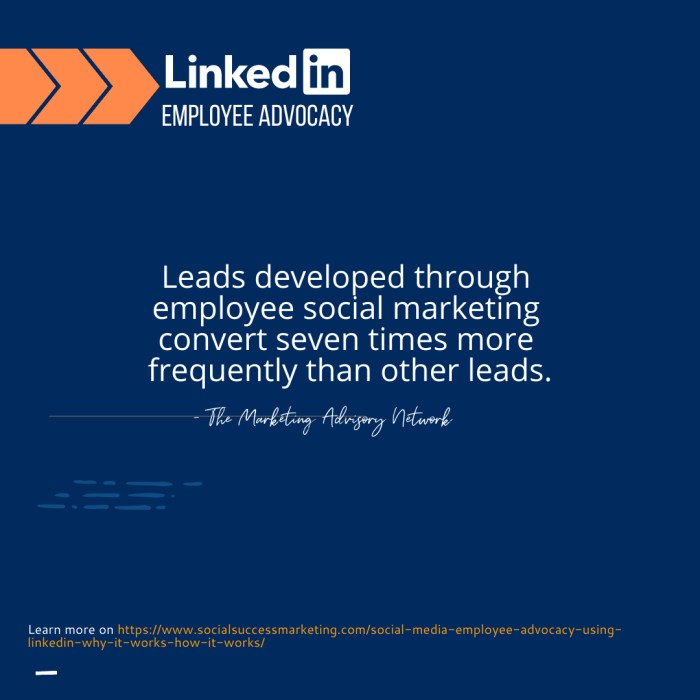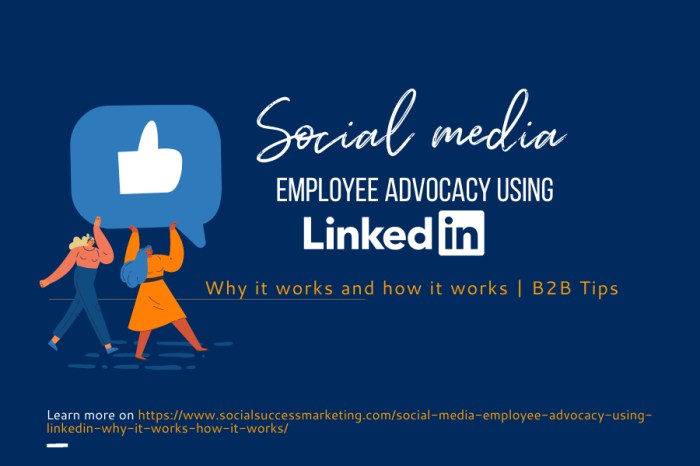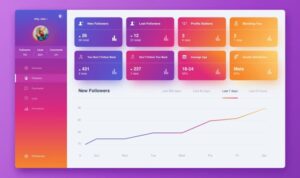Kicking off with Using LinkedIn for Employee Advocacy, this guide will show you how to leverage the power of LinkedIn to amplify your brand through employee advocacy. Get ready to dive into the world of social influence and maximize your impact!
Introduction to Employee Advocacy on LinkedIn
Employee advocacy on LinkedIn refers to the practice of employees sharing and promoting their company’s content, products, or services on their personal LinkedIn profiles. This can include sharing company updates, articles, job postings, and other relevant information to their network.
Using LinkedIn for employee advocacy offers several benefits, such as increasing brand awareness, enhancing the company’s credibility, and reaching a wider audience through employees’ connections. It also helps in building trust with potential clients or customers, as recommendations from employees are often seen as more authentic and trustworthy.
Examples of Successful Employee Advocacy Campaigns on LinkedIn
- Microsoft’s “Employee Takeover” campaign where employees shared behind-the-scenes content and personal stories, humanizing the brand and increasing engagement.
- IBM’s “Think Academy” program where employees shared thought leadership content and industry insights, positioning the company as a leader in the tech industry.
- Dell’s “Social Media and Training” initiative where employees were trained to effectively use LinkedIn for advocacy, resulting in a significant increase in brand visibility and lead generation.
Setting Up an Employee Advocacy Program on LinkedIn

To create an effective employee advocacy program on LinkedIn, it is essential to follow a few key steps. First, establish clear goals for the program, whether it’s increasing brand awareness, driving website traffic, or generating leads.
Identifying and Training Employee Advocates
Identifying the right employees to become advocates is crucial. Look for individuals who are active on LinkedIn, have a strong understanding of your brand, and are passionate about sharing content. Provide training on how to effectively engage with posts, use relevant hashtags, and maintain a consistent brand voice.
Encouraging Employee Participation
– Encourage employees to share content by creating a supportive environment where advocacy is valued and recognized.
– Provide incentives such as rewards, recognition, or gamification to motivate employees to participate.
– Make it easy for employees to share content by providing pre-approved posts, images, and links that they can easily repost on their own profiles.
Leveraging LinkedIn Features for Employee Advocacy

LinkedIn offers a plethora of features that can be optimized for employee advocacy, allowing employees to amplify the company’s message and reach a wider audience. Let’s delve into how these features can be leveraged effectively.
Optimizing LinkedIn Profiles for Employee Advocacy, Using LinkedIn for Employee Advocacy
- Encourage employees to complete their profiles with professional headshots, detailed work experience, and relevant skills.
- Include company-related s in their profiles to enhance visibility and searchability.
- Add links to company content, such as blog posts or videos, to showcase their involvement and support for the brand.
Utilizing LinkedIn Groups for Employee Advocacy Initiatives
- Join industry-specific or company-related groups to engage with like-minded professionals and share relevant content.
- Create private groups for employees to discuss advocacy strategies, share best practices, and coordinate efforts.
- Encourage employees to actively participate in group discussions, comment on posts, and share valuable insights to boost credibility.
Harnessing LinkedIn Pulse for Sharing Company Content
- Encourage employees to publish articles on LinkedIn Pulse to showcase their expertise, share industry insights, and promote company values.
- Share company updates, blog posts, and other content on LinkedIn Pulse to increase visibility and reach a wider audience.
- Engage with employees’ Pulse posts by liking, commenting, and sharing to amplify their reach and foster a culture of advocacy within the organization.
Measuring Success and ROI of Employee Advocacy on LinkedIn: Using LinkedIn For Employee Advocacy
In order to effectively measure the success and ROI of an employee advocacy program on LinkedIn, it is crucial to identify key metrics, employ suitable methods, and utilize the right tools and platforms for analysis.
Key Metrics for Tracking Success
- Engagement Rate: Monitor the level of engagement with employee-shared content, such as likes, comments, and shares.
- Reach: Measure the number of people exposed to employee advocacy posts and track the growth in reach over time.
- Click-through Rate (CTR): Analyze the percentage of clicks on shared links to evaluate the effectiveness of driving traffic.
- Lead Generation: Track the number of leads generated through employee advocacy efforts on LinkedIn.
Measuring ROI from Employee Advocacy
- Conversion Rate: Calculate the percentage of leads generated through employee advocacy that convert into actual customers.
- Cost per Lead (CPL): Determine the cost incurred for each lead acquired through the employee advocacy program.
- Revenue Attribution: Assess the contribution of employee advocacy activities to overall revenue generation.
- Customer Lifetime Value (CLV): Measure the long-term value of customers acquired through employee advocacy efforts.
Tools and Platforms for Analysis
- LinkedIn Analytics: Utilize the built-in analytics tools provided by LinkedIn to track the performance of employee advocacy posts.
- Employee Advocacy Platforms: Consider using specialized platforms like Hootsuite Amplify or Smarp for comprehensive analysis and management of advocacy activities.
- CRM Integration: Integrate employee advocacy data with Customer Relationship Management (CRM) systems to align advocacy efforts with sales and revenue data.
- Google Analytics: Leverage Google Analytics to measure website traffic and conversion rates driven by employee-shared content on LinkedIn.












